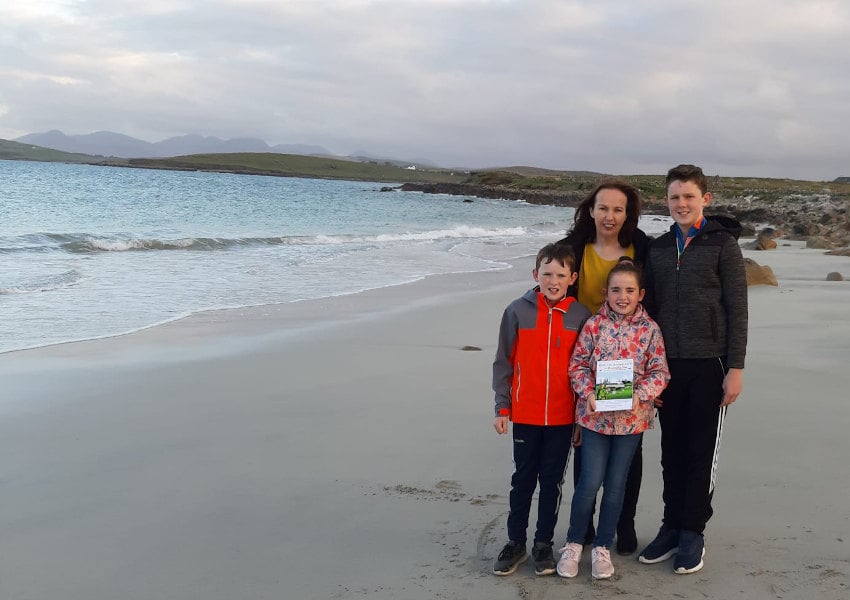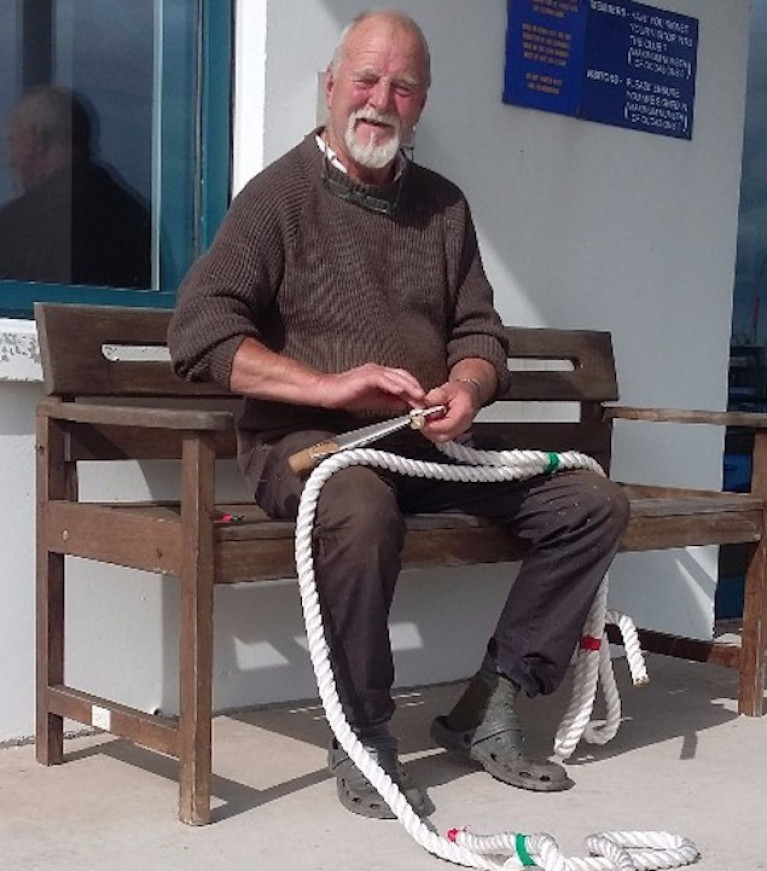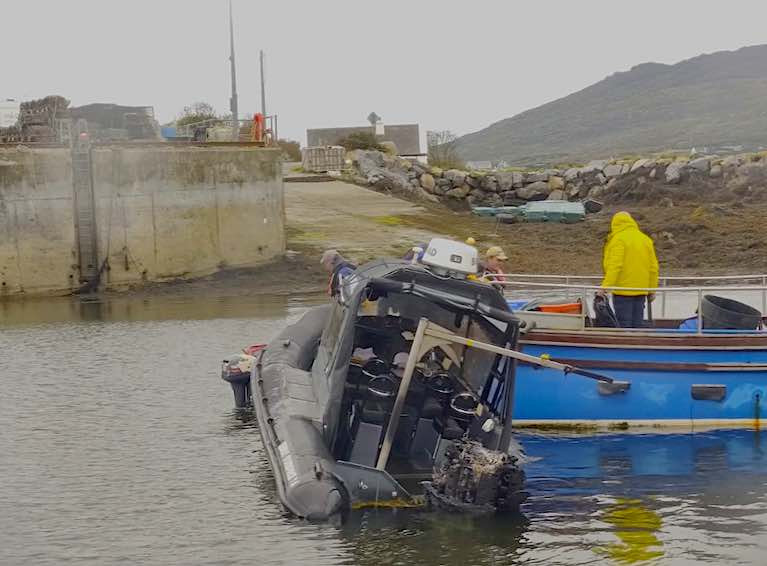Displaying items by tag: Clifden
A dad’s passion for the old Clifden RNLI lifeboat he served on has passed to the next generation as his son has purchased the first lifeboat his father helmed in 1996.
James Mullen, a coxswain at Clifden RNLI in Co Galway with over 27 years voluntary service saving lives at sea on the West Coast of Ireland, is also a proud dad to four boys who have inherited their father’s remarkable passion for the sea, the RNLI and everything to do with boats.
It’s this passion which inspired James’ 14-year-old son Ronan to track down and buy the C-class 522 inshore lifeboat which was stationed in Clifden between 1989 and 1997.
The boat holds so many memories for James as a teenage RNLI recruit and when his sons would ask him for the history of the station and his favourite lifeboat, the stories he told them always came back to the C-class.
Remembering his early crew years, James said: “I loved the sea, I had lived beside it my whole life and [then] finally, at 17 years old and with my parent’s consent, I was lifeboat crew.
“We had many call outs on the C-class and she was an amazing boat; she was hard on the back but she never failed to bring us home. This craft was the finest money could buy and I was so impressed with her.
“I remember a call one winter’s night in 1995, we were going to rescue a boat that had gotten into difficulty at sea. The weather was terrible with Force 7-8 westerly winds. It was up to us and our trusty C-class inshore lifeboat to get everyone home safe.
“As the seas got rougher, the C-class dug in deeper and when we were all safely back at shore I remember thinking what an incredible boat she was to stand up against those huge waves.”
 Clifden lifeboat crew at the old D-class station in 1995, when James was 18 years old | Credit: RNLI/Clifden
Clifden lifeboat crew at the old D-class station in 1995, when James was 18 years old | Credit: RNLI/Clifden
James’ beloved C-class was retired from service and left Clifden in 1997 but not much was known about her fate after that. So young Ronan, inspired by his father’s stories, embarked on an internet search to track her down.
Through various searches and online forums, Ronan established that the lifeboat went from Clifden to Ballyglas RNLI in Co Mayo for a short period, from there to the RNLI Museum in Poole and eventually to a private owner in the UK. Ronan located and struck up a friendship with the owner, who happened to be a fellow RNLI crew member based in Weston-Super-Mare.
Eventually, a deal was done, Ronan purchased his father’s favourite old lifeboat and the family brought her back to Clifden to the delight of the whole Mullen clan, Clifden RNLI crew and the many locals who remember her dutiful service.
Ronan describes the moment he found a photo of the lifeboat online: “I was so shocked, I had been looking online for ages and when I finally came across a photo of the C-class I said to Dad, is that her? And he said, it definitely is. After that I knew we had to have that boat. I love the boat, I love being out on the water and the minute I am old enough I will be joining the RNLI.”
James added: “Our station has grown a lot over the years thanks to the dedication of our volunteer crew, we now use an Atlantic 85 inshore lifeboat, a Shannon class all-weather lifeboat and are awaiting delivery of a very special boat next spring.
“Our new Shannon class ALB is being built at the moment and when she comes to Clifden she will carry the names of 10,000 loved ones from the launch a memory campaign.
“It’s a wonderful thing to see the next generation of lifeboat enthusiasts coming up, when I look at my four boys now I think, was I like they are now 27 years ago? Their whole life ahead of them and a future filled with love for the sea and the RNLI.”
Clifden Lifeboats Assist Six on Vessel With Engine Failure in Ballyconneely Bay
Clifden RNLI assisted six people yesterday evening (Tuesday 14 September) after their vessel broke down in Ballyconneely Bay.
Just after 6pm, the Connemara town’s all-weather and inshore lifeboats launched in response to reports that a 14ft vessel with multiple people onboard had suffered engine failure a few kilometres from shore.
The volunteer crews arrived on scene at 6.53pm and after assessed the situation and ensursing the six passengers were safe and well, a tow line was set up.
The all-weather lifeboat then towed the casualty vessel alongside the inshore lifeboat and transported the six passengers safely to shore on Ballyconeely Beach.
Clifden RNLI’s lifeboat operations manager John Brittain commended the volunteer crew for a timely response and successful outcome and reminded people to take all necessary precautions when going to sea.
“Plan your route in advance, carry out regular checks on your vessel prior to and during your journey,” he said. “Have means of calling for assistance if you find yourself in trouble, and everyone onboard should always be wearing lifejackets.”
The inshore lifeboat crew on this callout were helm Alan Pryce, Chris Nee, Brian Ward and Killian Whelan. The all-weather lifeboat crew included coxswain John Mullen, Joe Acton, Owen Hayes, Andy Bell, Thomas Davis and Kevin Ryan.
Four Clifden RNLI crew members who went to the aid of a sailor stranded on the rocks of Inishark have received letters of commendation for their role in the complex rescue operation.
On 20 September 2019, in severe weather conditions, Clifden RNLI’s all-weather Shannon class and inshore Atlantic 85 lifeboats were launched at the request of the Irish Coast Guard.
A sailor had come into difficulty after his yacht suffered engine failure at Inishark island. The volunteer crew were on the scene within 30 minutes and located the casualty who had made his way onto the rocks.
As previously reported on Afloat.ie, he operation was hampered by a south-east Force 7/8 onshore wind but helm Alan Pryce, using experience and training, was able to safely put a crew member ashore to assess the casualty.
The casualty did not have life-threatening injuries but given the severity of the weather, the safest option was to request the assistance of the coastguard’s Sligo-based helicopter Rescue 118 which winched the sailor to safety.
Clifden RNLI volunteers Alvin Bell, his father Andy Bell, Ian Shanahan and Alan Pryce crewed Clifden’s Atlantic 85 lifeboat during this challenging rescue operation and they recently received letters of commendation from John Payne, the RNLI director of lifesaving operations, for their service.
John Brittain, Clifden RNLI lifeboat operations manager, congratulated the crew: “Alvin, Andy, Ian and Alan have shown continued commitment to Clifden RNLI and I am delighted that their selfless courage and dedication has been recognised with a letter of commendation.
“This particular rescue highlights the level of training, skills and seamanship of our volunteer members and we are very grateful for the role they play in saving lives at sea.”
Clifden RNLI assisted in the rescue of four sea kayakers who got into difficulty off Inishark Island on Saturday afternoon (15 May).
Both the station’s all-weather Shannon class lifeboat under Coxswain John Mullen and the inshore Atlantic 85 class lifeboat helmed by David Barry, were launched at 3.30 pm after the alarm was raised with the Irish Coast Guard following the activation of an Emergency Position Indicating Radio Beacon (EPIRB). The request was to go the aid of four people on the north side of Inishark, approximately eight nautical miles offshore.
Weather conditions at the time were poor with a 3m swell and a difficult tide.
"All four kayaks had been overturned by a large wave with one completely swamped"
All four kayaks had been overturned by a large wave with one completely swamped leaving a casualty in the water clinging to the bow of another of the kayaks. On arrival, the volunteer lifeboat crew observed that the crew of a local rigid inflatable boat had taken two of the kayakers onboard including the casualty whose kayak was swamped, while the other two were making their way to safety themselves.
The inshore lifeboat proceeded to escort the local vessel with two of the kayakers safely back to Inishbofin while the all-weather lifeboat escorted the other two kayakers safely back to shore.
Speaking following the call out, John Brittain, Clifden RNLI Lifeboat Operations Manager praised the kayakers for going to sea with the right gear and equipment: ‘The kayakers got caught by a large swell in an inaccessible area, but they had done all the right things which made a huge difference. They were all wearing drysuits and lifejackets. A personal locator beacon also served its purpose in raising the alarm and the kayakers need to be commended for also carrying that.
‘We would remind anyone planning a trip to sea this summer to always respect the water. Always have the correct safety gear and equipment, always check the weather and tide times before venturing out and always let someone on the shore know where you are going and when you are due back. Should you get into difficulty, call 999 or 112 and ask for the Coast Guard.’
Clifden RNLI came to the aid of two walkers who got cut off by the tide yesterday evening (Sunday 11 April).
The volunteer crew were requested to launch the lifeboat by the Irish Coast Guard at 5.50 pm following a report that two people were stranded on Omey Island.
The inshore Atlantic 85 class lifeboat helmed by Kenny Flaherty and with three crew members onboard, launched immediately and made its way to the scene.
Weather conditions at the time were good with a northerly Force 5 wind.
Once on scene, the lifeboat crew checked that the two people were safe and well before proceeding to transfer them on to the lifeboat and bring them back to shore at Claddaghduff.
Speaking following the call out, John Brittain, Clifden RNLI Lifeboat Operations Manager said: ‘The two walkers were not in any immediate danger and we were happy to help and bring them safely back to shore.
‘We would remind locals and visitors to always check tide times and heights before venturing out and to always make sure you have enough time to return safely.
‘If you do get cut off by the tide, it is important to stay where you are and not attempt a return to shore on your own as that may be when the danger presents and you get into difficulty. Always carry a means of communication and should you get into difficulty or see someone else in trouble, dial 999 or 112 and ask for the Coast Guard.’
Clifden RNLI Lifeboat Involved in Search Operation after EPIRB is Accidentally Activated off Connemara Coast
Clifden RNLI launched both its Shannon class all-weather and Atlantic 85 inshore lifeboats this morning (Friday 26 February) after an EPIRB (Emergency Position Indicating Radio Beacon) was accidentally activated, giving a position west of Turbot Island.
The volunteer crews were requested to launch their lifeboats at 9.28 am and they immediately made their way to the scene. An Irish Coast Guard helicopter was also tasked.
Weather conditions at the time were good with a south-westerly Force 4 wind, good visibility, and a moderate ground swell.
The lifeboat crews conducted a thorough search for approximately two and a half hours, but nothing was found. During the search, information was relayed to the crews that the EPIRB may have been accidentally activated at a property on a nearby empty island. The crew conducted a shoreline search on the island. The search was subsequently called off and the lifeboats were stood down at 12.19 pm.
Speaking following the call out, John Brittain, Clifden RNLI Lifeboat Operations Manager said: ‘While we were quite concerned when the pagers went off this morning, we are glad that all is well and that no one was in danger. This was a false alarm in the sense that an EPIRB was accidentally activated, but we would always much rather launch and search to ensure everything is ok, than not launch at all.
‘I would like to commend our volunteers and our colleagues in the Irish Coast Guard for their teamwork in today’s search. We would encourage anyone who gets into difficulty or sees someone else in trouble, to dial 999 or 112 and ask for the Coast Guard.’
The Name of the Late Don Clarke of Strangford Lough Yacht Club Will be on the New Clifden Lifeboat
It's a long way from Whiterock on Strangford Lough to Clifden in County Galway where the new Shannon class all-weather lifeboat will be stationed in 2022. It will be the second such vessel to be part of the charity's 'Launch a Memory' fundraising campaign and the first to be based in Ireland.
There will be space for 10,000 names on the hull and one which will be there is that of the late Don Clarke, long time boatman at Strangford Lough Yacht Club where he was also in charge of the clubhouse and grounds and involved in club safety boat services. He was an Auxiliary Coastguard for Whiterock and Portaferry area. His niece Gillian Clarke, instead of sending cards at Christmas, has donated to the RNLI in memory of her Uncle Don; "As an RNLI volunteer and an Auxiliary Coastguard Don helped save many lives over the years" Gillian said, "In his memory, I wish all my family and friends, near and far, a very Peaceful Christmas and a better New Year for us all in 2021".
Originally from Crosshaven, in Cork Harbour, Don joined the Club in 1969 and worked there until he retired. He passed away in August last.
Through the 'Launch a Memory' campaign, members of the public and supporters of the charity will be able to commemorate a loved one by donating online and submitting that person's name. The name of each person being remembered will be featured within the lifeboat's letters (RNLI) and numbers, or decal, displayed on the vessel's hull in lettering 3-4mm in height. The first Launch a Memory lifeboat is due to go on service in Invergordon, Scotland.
The honour of the first name on the new lifeboat will go to a young lifeboat volunteer, Lee Early (26), from Donegal, who tragically lost his life last year when he was involved in an accident on Arranmore Island.
Daniel Curran, RNLI Engagement Lead, said: "We are so pleased to be able to bring Launch A Memory' to Ireland, with a lifeboat that will save lives off our coast for generations. Everyone who supports the campaign will receive email updates about the lifeboat, keeping them informed of all major developments on its journey to going on service and saving lives at sea in Clifden."
There are three ways people can get the name of a loved one on the Launch a Memory lifeboat. Donations can be made online at rnli.org/launchamemory by phone on 01-895 1800 (Monday to Friday 8 am to 6 pm) or alternatively by post to RNLI, Airside, Swords, County Dublin K67 WA24. There is a suggested donation of €30 with space to commemorate up to 10,000 names on the lifeboat.
Clifden RNLI Lifeboats Recover Sinking Trawler with Two Onboard
Both lifeboats at Clifden RNLI were launched this morning just before 11 am after a Coastguard request to go to the aid of a ten-metre fishing trawler that was taking on water and in danger of sinking.
With two crew on board, the trawler was on passage to Clare when they raised the alarm.
While wind conditions were a south westerly force 3/4, there was a very large swell on the scene and another large tanker vessel nearby.
All weather lifeboat coxswain James Mullen explained ‘When the lifeboats arrived on scene there was a large tanker vessel providing the casualty vessel with some shelter from the 7/8 meter seas.
 .With two crew on board, the trawler was on passage to Clare when they raised the alarm
.With two crew on board, the trawler was on passage to Clare when they raised the alarm
The Atlantic 85 helm Joe Acton immediately transferred two crew aboard with a salvage pump and began pumping out the vessel. Once the water level dropped low enough for the vessel to use their own engine power we headed back to shore.
However, on the way to Clifden the boat started to take on more water than the two pumps could handle and the engine overheated so we made the decision then to take her under tow. The larger salvage pump was transferred from the Shannon class lifeboat to the casualty via the inshore lifeboat by crew member Chris Nee.
With both lifeboats pumps working and the vessels own bilge pump, the flow of water was stemmed and the boat was escorted safely back to Clifden. Both helicopters Rescue 115 and 118 were also on scene and we are glad to have been able to bring the casualties and the vessel safely back to shore’.
Clifden RNLI Deputy Launching Authority John Roberts said ‘The crew did extremely well today in a very large swell to carry out this rescue and without their assistance this vessel was in serious danger of sinking. Well done to all involved.’
The Shannon class lifeboat was crewed by James Mullen, John Mullen, Ashling Sweeney, Chris Nee and Andrew Bell and the Atlantic 85 boat was crewed by Joe Acton, Brian Ward and Thomas Davis.
Launch of New Irish Children’s Book on Connemara is a Boost to Clifden Lifeboat Team
A new children’s book focusing on the local history and mythology of the North West Connemara region has been launched this week in Co Galway.
And a portion of the proceeds is being donated to the Clifden RNLI lifeboats for their dedication to saving lives at sea.
Local author and youth worker Marie Feeney has produced From Our Ancient Land to Bountiful Sea, an informative and often humorous collection of local history and folklore tales with illustrations by Gary Kendellen.
These tales include accounts of the famous engineer Alexander Nimmo, who designed many piers and bridges in the Connemara area, and a blend of local history and myths that will appeal to locals and visitors alike.
Marie’s first book The Cleggan Disaster comprehensively and poignantly detailed the tragic drowning of 45 men from the fishing communities of Cleggan, Claddaghduff and Inishbofin and the Inishkeas, and also benefitted the local RNLI lifeboats.
 Author Marie Feeney with her children Ronan, Diarmuid and Michaela at Sallerna Beach in Cleggan, Co Galway | Photo: Marie Feeney
Author Marie Feeney with her children Ronan, Diarmuid and Michaela at Sallerna Beach in Cleggan, Co Galway | Photo: Marie Feeney
On the launch of her new book, Marie said: “The coastline of Connemara, while exceptionally beautiful is also treacherous and mostly utilised by people who use it either for pleasure or their livelihood.
“Thankfully in our community, we have a dedicated RNLI volunteer team who provide an invaluable service by saving lives each year, sometimes in the most challenging environments.
“The philosophy of the RNLI is astounding. The purpose to save lives, their vision to save everyone, their volunteer ethos, their charitable and community base. Every life matters, and of course their maritime expertise is crucial.”
From Our Ancient Land to Bountiful Sea is now on sale locally in Connemara at The Clifden Bookshop, Letterfrack Country Shop, Gala Cleggan and Sweeney’s Claddaghduff. The book is also available online at the inConnemara Bookshop.
Clifden RNLI Launch to Fire on Diver's RIB in Roundstone
Three divers were rescued by the RNLI Clifden lifeboat yesterday after their rigid inflatable boat (RIB) caught fire in Bertraghboy bay near Roundstone, Co Galway.
Shortly before 3 pm yesterday (Monday, Sept 21st) Clifden RNLI launched their Shannon class all-weather lifeboat in response to a Mayday call to the Coastguard from a Rigid Inflatable Boat (RIB) that had caught fire in Bertraghboy Bay near Roundstone.
The three people on board had inflated their life raft, evacuated the RIB and were taken under tow by a local fishing vessel. They had been diving approximately 3 miles offshore when the incident happened.
Clifden RNLI said that the three people on board had inflated their life raft, evacuated the RIB and were taken under tow by a local fishing vessel. They had been diving approximately three miles off shore when the incident happened.
The Shannon class lifeboat Brianne Aldington arrived at the scene approximately 55 minutes after launch, it said.
Aran Island RNLI, which had also been requested to launch, was stood down shortly afterwards - as was Clifden’s Atlantic 85 inshore lifeboat, once it was clear the situation was under control, it said.
The Irish Coastguard helicopter Rescue 115 from Shannon was on scene while the lifeboat escorted the casualties into Inishnee pier, where they were met by members of Cleggan Coastguard.
Coxswain James Mullen said ‘“While this was obviously a very upsetting thing to happen, the boat was very well equipped and the sailors had taken every safety precaution to deal with an emergency scenario like this. “
“We wish them well and commend their quick actions and also of course the local vessel that went to their aid as quickly as possible, in what have could otherwise have been a disastrous incident, “ Mr Mullen added.
































































